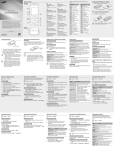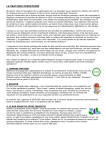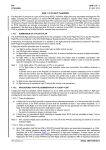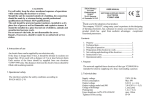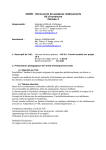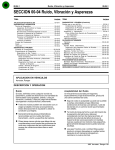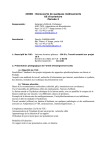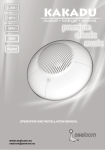Download ENR 1.10 FLIGHT PLANNING
Transcript
28 MAY 2015 AIP CROATIA ENR 1.10 - 1 28 MAY 2015 ENR 1.10 FLIGHT PLANNING ENR 1.10.1 FLIGHT PLAN ENR 1.10.1.1 General Information related to an intended flight or portion of a flight, to be provided to air traffic services units, shall be in the form of a flight plan. The purpose of a flight plan is to inform the competent ATS units enabling them to supervise the flight within the scope of air traffic control as well as the flight information service and alerting service. ENR 1.10.1.2 Types of flight plan ENR 1.10.1.2.1 Individual flight plan For each individual flight, for which the filing of a flight plan is mandatory or the pilot would like to file a flight plan, an individual flight plan (FPL) shall be filed. Flights, in which several aircraft take part in a formation, as well as every separate stage of a flight for flights with intermediate stops, shall also be regarded as an individual flight. ENR 1.10.1.2.2 Repetitive flight plan For at least ten (10) IFR flights planned by the same aircraft operator, a repetitive flight plan may be filed provided that these flights are planned to be conducted regularly, in the same manner and at least once a week. ENR 1.10.2 PROCEDURES FOR THE SUBMISSION OF A FLIGHT PLAN A flight plan shall be submitted to the competent ATC unit prior to operating: a. any IFR flight; b. any VFR flight in controlled airspace, except for VFR flights within controlled zone during daytime; c. flights in flight restricted areas if it is implicitly required upon establishment of the relevant areas; d. VFR flights leaving or entering the Republic of Croatia. The pilot may also submit a flight plan for other flights to the competent ATC unit in order to facilitate the execution of Search and Rescue Service for aircraft. In order to process flight plan messages correctly, each flight plan shall be sent as a single AFTN message. No flight plans shall be filed via the airspace of Zagreb FIR deviating from the State restrictions defined within the Route Availability Document (RAD). This common European reference document contains all airspace utilization rules and availability for Zagreb FIR and any reference to them shall be made via https:// www.nm.eurocontrol.int/RAD/index.html. ENR 1.10.2.1 Time of submission Except for repetitive flight plans, a flight plan shall be submitted at least 60 minutes prior to EOBT, taking into account the requirements of ATS units in the airspace along the route to be flown for timely information. Flight plans for flights into areas subject to ATFCM shall be submitted at least 3 hours before EOBT. Flight plans may be submitted to IFPS up to a maximum of 120 hours, or five days, in advance of the EOBT of that flight plan. If a flight plan is filed more than 24 hours in advance of the estimated off-block time of the flight to which it refers, the date of the flight departure shall be inserted in Item 18 of the flight plan. © Croatia Control Ltd. AIRAC AIP AMDT 006/2015 29 MAY 2014 ENR 1.10 - 2 29 MAY 2014 AIP CROATIA ENR 1.10.2.2 Place of submission Aircraft operators shall file their IFR or IFR/VFR (mixed) flight plans and associated messages (e. g. CHG, DLA, CNL) before departure directly with IFPS using their own AFTN or SITA access point in accordance with addressing principles set in AIP Croatia, ENR 1.11 Addressing of flight plan messages. If those means are not available, flight plan and associated messages shall be submitted at the Air Traffic Services Reporting Office (ARO) at the departure aerodrome. Direct filers take the full responsibility for compliance with all relevant IFPS procedures including complete addressing of their messages. VFR and VFR/IFR (mixed) flight plans and associated messages shall be normally filed at the competent ARO at the departure aerodrome in accordance with addressing principles set in AIP Croatia, ENR 1.11 Addressing of flight plan messages. For all other flights, flight plans may be filed with competent ARO for forwarding to the unit responsible for the aerodrome of departure in accordance with addressing principles set in AIP Croatia, ENR 1.11 Addressing of flight plan messages. When the departure aerodrome is different from the place of filing a flight plan, a FPL for an IFR flight is forwarded to IFPS, while a FPL for a VFR flight is forwarded only to the ARO at the departure airport. ARO shall forward such FPL further to all required addresses. In case of absence of ARO at the departure aerodrome or in case the ARO is not in operation, a flight plan shall be submitted by telephone, e-mail or via Telefax to the nearest ARO. Contact information (Tel, Fax, e-mail etc.) are given in part GEN 3.3. ARO service at aerodromes is provided by the local briefing unit or by the local TWR or AFIS. ENR 1.10.2.3 Filing of flight plans with IFPS directly Flight plans and flight plan associated messages filed directly with IFPS will be checked by IFPS as regards syntax, format and route structure. The originator will be informed of the processing of flight plans and flight plan associated messages within IFPS through Operational Reply Messages (ORM). • MAN - the message is not correct and will be amended manually • REJ - the message is not correct and cannot be amended, a correct version has to be sent • ACK - the message is correct and accepted by IFPS ENR 1.10.2.4 Flight plan submission via Telefax, phone or e-mail If the flight plan is submitted via Telefax or e-mail it has to be confirmed by the pilot (submitter of the flight plan) immediatelly after transmission via telephone, otherwise it will not be processed. The flight plan form of CROATIA CONTROL Ltd. or a form produced by a computer shall be used for transmission. The form has to be fully and legibly filled in. A contact TEL/FAX number has to be given in the interest of the pilot-in-command. When a flight plan is submitted by telephone, the ICAO sequence of items in the flight plan form shall be strictly followed. The flight plan originator is responsible for: a. Completeness and correctness of data; b. Obtaining pre-flight information and necessary ATC clearances; AIRAC AIP AMDT 006/2014 © Croatia Control Ltd. 29 MAY 2014 AIP CROATIA ENR 1.10 - 3 29 MAY 2014 c. Check of the flight feasibility; d. Complete addressing; e. The forwarding of messages. ENR 1.10.2.5 Submission of flight plans during flight (AFIL) Flight plan may be filed during flight if required by certain circumstances unknown to the pilot prior to departure. Flight plans filed during flight (AFIL) shall not be accepted: • for flights with en-route stops • for international flights The flight plan shall be submitted to the nearest ATS unit in operation or to the ACC. ENR 1.10.2.6 VFR flight plan for alerting service only An alerting service is, in principle, provided to flights for which a flight plan has been submitted. © Croatia Control Ltd. AIRAC AIP AMDT 006/2014 29 MAY 2014 ENR 1.10 - 4 29 MAY 2014 ENR 1.10.3 AIP CROATIA CONTENTS AND FORM OF A FLIGHT PLAN ICAO flight plan forms are available at AROs and aerodrome offices at uncontrolled aerodromes. Electronic copy of ICAO FPL form is available at www.crocontrol.hr. The instructions for completing those forms shall be followed. ENR 1.10.3.1 Contents of a Flight Plan A flight plan shall be completed in accordance with the provisions specified below: ENR 1.10.3.1.1 Aircraft Identification – Item 7 The aircraft identification in a message shall contain a minimum of two (2) and a maximum of seven (7) alphanumeric characters and without hyphens or symbols as follows: 1. The ICAO telephony designator of the aircraft operating agency followed by the flight identification when in radiotelephony the call sign to be used by the aircraft will consist of the ICAO telephony designator for the operating agency followed by the flight identification. or the nationality or common mark and registration mark of the aircraft when: a. In radiotelephony the call sign to be used by the aircraft will consist of this identification alone, or preceded by the ICAO telephony designator for the aircraft operating agency; b. The aircraft is not equipped with radio; 2. A radio telephony call sign used for military aircraft. 3. If several aircraft are involved, the registration mark of the leading aircraft or of the aircraft taking off first shall be indicated. The registration marks of other aircraft shall be indicated in Item 18, preceded by the identification group "REG/". ENR 1.10.3.1.2 Flight Rules and Type of Flight – Item 8 The following indications of flight rules may be used in Item 8a for a flight plan: • I - if it is intended that the entire flight will be operated under the IFR • V - if it is intended that the entire flight will be operated under the VFR • Y - if the flight initially will be operated under the IFR, followed by one or more subsequent changes of flight rules or • Z - if the flight initially will be operated under the VFR, followed by one or more subsequent changes of flight rules Specify in Item 15 the point or points at which a change of flight rules is planned. VFR flights at night shall be marked by the entry “RMK/N VFR NIGHT” in Item 18. The following types of flight may be used in Item 8b for a flight plan: • S - if scheduled air service • N - if non-scheduled air transport operation • G - if general aviation • M - if military (in addition to military operations, operators of customs or police aircraft shall insert the letter "M" in Item 8b). State aircraft (aircraft used in military, customs and police service) intending to conduct flights within RVSM airspace shall indicate the type of flight (Item 8b) with the letter "M". AIRAC AIP AMDT 006/2014 © Croatia Control Ltd. 07 FEB 2013 AIP CROATIA ENR 1.10 - 5 07 FEB 2013 • X - if other than any of the defined categories above. When using the letter “X”, supplementary information concerning the intention of the flight shall be given in the Item 18 of the flight plan preceded by the identification group "RMK/". Example: RMK/LIC TG (“touch and go”) RMK/LIC LA (“low approach”) ENR 1.10.3.1.3 Number and Type of Aircraft and Wake Turbulence Category – Item 9 If more than one aircraft type intends to fly in formation, the total number of aircraft shall be given. The type of aircraft shall be indicated by the type designator assigned by ICAO in compliance with ICAO Doc. 8643. If no aircraft type designator has been assigned to an aircraft type by ICAO, the letter group "ZZZZ"shall be inserted and the aircraft type shall be specified in Item 18, preceded by the identification group "TYP/". Example: Item 9: ZZZZ Item 18: TYP/LJ39 In case of a flight with different types of aircraft, the type designator of the leading aircraft or of the aircraft taking off first, shall be indicated, and all other aircraft types shall be detailed in Item 18, preceded by the identification group "TYP/". Examples: Item 9: 2AN26 Item 18: TYP/1AN26 1LJ39 or TYP/AN26 LJ39 Item 9: 5F15 Item 18: TYP/2F15 3F5 The wake turbulence category of an aircraft shall be indicated by adding one of the following letters, separated by an oblique stroke from the aircraft type identification: • J (super) - shall be inserted at present exclusively for A380-800 (A388) • H (heavy) - shall be inserted for an aircraft with a maximum certified take off mass of 136000 KG or more • M (medium) - shall be inserted for an aircraft with a maximum certified take off mass of less than 136000 KG but more than 7000 KG • L (light) - shall be inserted for an aircraft with a maximum certified take off mass of 7000 KG or less ENR 1.10.3.1.4 Equipment – Item 10 Capabilities comprise the following elements: a. presence of relevant serviceable equipment on board the aircraft; b. equipment and capabilities commensurate with flight crew qualifications; and c. where applicable, authorization from the appropriate authority. The radio communication, navigation and approach aid equipment and capabilities as well as, separated by an oblique stroke, surveillance equipment and capabilities, shall be indicated. ENR 1.10.3.1.4.1 Radio communication, navigation and approach aid equipment and capabilities - Item 10a Radio communication, navigation and approach aid equipment and capabilities shall be indicated: • N - if no COM/NAV/ approach aid equipment for the route to be flown is carried or the equipment is unserviceable • S - if standard COM/NAV/ approach aid equipment for the route to be flown (VHF RTF, VOR and ILS) is carried and serviceable; © Croatia Control Ltd. AIRAC AIP AMDT 001/2013 07 FEB 2013 ENR 1.10 - 6 07 FEB 2013 AIP CROATIA AND/OR One or more of the following letters to indicate the serviceable COM/NAV/ approach aid equipment and capabilities: • A GBAS landing system • B LPV (APV with SBAS) • C LORAN C • D DME • E1 FMC WPR ACARS • E2 D-FIS ACARS • E3 PDC ACARS • F ADF • G GNSS (see Note 1) • H HF RTF • I Inertial Navigation • J1 CPDLC ATNVDL Mode 2 • J2 CPDLC FANS 1/A HFDL • J3 CPDLC FANS 1/A VDL Mode A • J4 CPDLC FANS 1/A VDL Mode 2 • J5 CPDLC FANS 1/A SATCOM (INMARSAT) • J6 CPDLC FANS 1/A SATCOM (MTSAT) • J7 CPDLC FANS 1/A SATCOM (Iridium) • K MLS • L ILS • M1 ATC RTF SATCOM (INMARSAT) • M2 ATC RTF (MTSAT) • M3 ATC RTF (Iridium) • O VOR • P1-P9 Reserved for RCP • R PBN approved (see Note 2) • T TACAN • U UHF RTF • V VHF RTF • W RVSM approved AIRAC AIP AMDT 001/2013 © Croatia Control Ltd. 07 FEB 2013 AIP CROATIA ENR 1.10 - 7 07 FEB 2013 • X MNPS approved • Y VHF with 8.33 kHz channel spacing capability • Z Other equipment carried or other capabilities (see Note 3) Note 1: If the letter “G” is used, the types of external GNSS augmentation, if any, are specified in Item 18 following the indicator NAV/ and separated by a space. Note 2: If the letter “R” is used, the performance based navigation levels that can be met are specified in Item 18 following the indicator PBN/. Note 3: If the letter “Z” is used, specify in Item 18 the other equipment carried or other capabilities, preceded by “COM/”, “NAV/” and/or “DAT/”, as appropriate. Exemptions for RNAV, CPDLC and 8.33 kHz are to be indicated by inserting the letter Z in Item 10a and then inserting the appropriate descriptors in the following indicators in Item 18 as detailed in the IFPS Users Manual: a. insert EXM833 following COM/; b. insert RNAVX or RNAVINOP as appropriate following NAV/; c. insert CPDLCX following DAT/. ENR 1.10.3.1.4.2 Surveillance equipment and capabilities - Item 10b INSERT N if no surveillance equipment for the route to be flown is carried, or the equipment is unserviceable, OR INSERT one or more of the following descriptors, to a maximum of 20 characters, to describe the serviceable surveillance equipment and/or capabilities on board: SSR Modes A and C A Transponder — Mode A (4 digits — 4 096 codes) C Transponder — Mode A (4 digits — 4 096 codes) and Mode C SSR Mode S E Transponder — Mode S, including aircraft identification, pressure-altitude and extended squitter (ADS-B) capability H Transponder — Mode S, including aircraft identification, pressure-altitude and enhanced surveillance capability I Transponder — Mode S, including aircraft identification, but no pressure-altitude capability L Transponder — Mode S, including aircraft identification, pressure-altitude, extended squitter (ADSB) and enhanced surveillance capability P Transponder — Mode S, including pressure-altitude, but no aircraft identification capability S Transponder — Mode S, including both pressure altitude and aircraft identification capability X Transponder — Mode S with neither aircraft identification nor pressure-altitude capability Note: Enhanced surveillance capability is the ability of the aircraft to down-link aircraft derived data via a Mode S transponder. ADS-B B1 ADS-B with dedicated 1090 MHz ADS-B “out” capability B2 ADS-B with dedicated 1090 MHz ADS-B “out” and “in” capability U1 ADS-B “out” capability using UAT U2 ADS-B “out” and “in” capability using UAT V1 ADS-B “out” capability using VDL Mode 4 V2 ADS-B “out” and “in” capability using VDL Mode 4 ADS-C © Croatia Control Ltd. AIRAC AIP AMDT 001/2013 07 FEB 2013 ENR 1.10 - 8 07 FEB 2013 AIP CROATIA D1 ADS-C with FANS 1/A capabilities G1 ADS-C with ATN capabilities Note: Additional surveillance application should be listed in Item 18 following the indicator SUR/ ENR 1.10.3.1.5 Aerodrome of Departure and Estimated Off-Block Time – Item 13 Any flight plan shall indicate the aerodrome of departure (ADEP) using the ICAO four-letter designator, where that designator is known. If no ICAO location indicator has been assigned to the departure aerodrome, the letter group “ZZZZ“ and the name of the departure aerodrome and location, referring to the nearest locality depicted on the Aeronautical Chart ICAO 1:500000 shall be indicated in Item 18 preceded by the identification group “DEP/“. If the aircraft has not taken off from the aerodrome, the first point of the route or the marker radio beacon preceded by “DEP/”, shall be inserted. If a flight plan is filed during the flight, the letter group “AFIL“ shall be entered instead of indicating the departure aerodrome and the air traffic control unit, from which supplementary flight plan data may be requested, shall be indicated in Item 18 together with the identification group “DEP/“. The Estimated Off-Block Time (EOBT) shall be indicated by a four figure group following the designation of the departure aerodrome. For those flights with the departure point given as AFIL, the associated time shall indicate the Estimated or Actual Time Over the point on the route from where the flight plan shall apply. ENR 1.10.3.1.6 Route – Item 15 ENR 1.10.3.1.6.1 Cruising speed – Item 15a The data concerning the true air speed, the estimated ground speed where manned free balloons are concerned, the cruising level requested and the intended route shall be indicated in Item 15. Cruising speed may be indicated: • N followed by four figures – indication in knots • M followed by three figures – indication of the Mach number in hundreds • K followed by four figures – indication in km/h. The first digits of the figure group expressing the speed shall be completed by the figure "0", if necessary. Changes of speed by 5% or more shall be indicated in the route. Kilometres per hour shall not be used for general air traffic (GAT) route segments within Republic of Croatia. ENR 1.10.3.1.6.2 Cruising level – Item 15b The data concerning the cruising level requested shall be given without a space following the speed data. The first digits shall be completed by the figure "0", if necessary. Level may be indicated in the following ways: • F followed by three (3) figures – Indication of the flight level • A followed by three (3) figures – Indication of the altitude in hundreds of feet. • VFR - for uncontrolled VFR flights, except for VFR flights at night in controlled airspace, for flights subject to ATC, or for VFR flights intended to be performed at a definite level. The indication of the requested cruising level in metres or in flight levels in accordance with the metric system is acceptable for routes outside Republic of Croatia as far as such data are prescribed. AIRAC AIP AMDT 001/2013 © Croatia Control Ltd. 07 FEB 2013 AIP CROATIA ENR 1.10 - 9 07 FEB 2013 These shall then be indicated as follows: • S followed by a 4-figure group – Indication of the metric flight level in tens of metres • M followed by a 4-figure group – Indication of the metric altitude in tens of metres. Changes to the cruising level requested shall be indicated in the route. ENR 1.10.3.1.6.3 Route – Item 15c The data about the requested route shall be entered in Item 15 (Route) of the flight plan. For IFR approaches and departures (SID/STAR) and flights on ATS routes, the abbreviated designations (identifications) established for such routes shall be indicated. In case a standard instrument arrival/departure route has not been established for an aerodrome, the identification group “DCT“ shall be entered as the first and/or last route element. Where a flight intends to fly on a route, the route given in the flight plan shall indicate the point at which the flight intends to join that route and the point at which the flight intends to leave that route. For flights outside the published ATS routes, the identification group “DCT“ (direct) shall be inserted between the specified points in order to indicate the direct route of flight between two points. The use of a "DCT" shall be avoided wherever possible. Crossing of Croatian border on a DCT routing is not allowed. For flights outside designated ATS routes outside Republic of Croatia, points normally not more than 30 minutes flying time or 200 NM apart shall be inserted. For IFR flights within the Republic of Croatia, the pilot shall consult the contents of the Integrated Aeronautical Information Package (IAIP) when planning routes. In addition, he may also refer to the contents of the Route Availability Documents (RAD). For VFR flights entering Croatia, the point of crossing the international border, related to the nearest larger locality depicted on the Aeronautical Chart ICAO 1:500000 or to a navigation aid, shall be indicated in Item 18 by the identification group “EET/“. When conducting VFR flights at night in controlled airspace the indicated route shall be the one closest to the published ATS routes. For VFR flights on recommended VFR route within the Republic of Croatia the route given in the flight plan shall indicate the point at which the flight intends to join that VFR route and the point at which the flight intends to leave that route. The route shall be described using the following elements: a. ATS route (2 to 7 characters) - the coded designator assigned to the route or route segment including, where appropriate, the coded designator assigned to the standard departure or arrival route. b. Significant point (2 to 11 characters) - the coded designator (2 to 5 characters) assigned to the point or, if no coded designator has been assigned, in the following way: • Degrees and minutes (11 characters): 4 figures describing latitude in degrees and tens and units of minutes followed by “N” (North) or “S” (South), followed by 5 figures describing longitude in degrees and tens and units of minutes, followed by “E” (East) or “W” (West). The first digits of the figure groups shall be completed by the figure "0", if required. • Bearing and distance from significant point: the identification of the significant point, followed by the bearing from the point in the form of 3 figures giving degrees magnetic, followed by the distance from the point in the form of 3 figures expressing nautical miles. The first digits of the figure groups shall be completed by the figure "0", if required. © Croatia Control Ltd. AIRAC AIP AMDT 001/2013 07 FEB 2013 ENR 1.10 - 10 07 FEB 2013 AIP CROATIA c. Change of speed or level (maximum 21 characters) - the point at which a change of speed (5% TAS or 0.01 Mach or more) and/or a change of level is planned to commence, even when only one of these values will be changed. d. Change of flight rules (maximum 3 characters) - the point at which the change of flight rules is planned, followed by a space and one of the following: • VFR if from IFR to VFR • IFR if from VFR to IFR For routes outside Republic of Croatia the cruise climb may be indicated by using a maximum of 28 successive characters as defined below: • The letter "C" followed by an oblique stroke and the indication of the route point from where the cruise climb is intended. Separated by an oblique stroke, the speed during cruise climb will follow as well as either the two flight levels defining the airspace occupied during cruise climb, or the flight level at which the cruise climb is commenced, followed by the word "PLUS". Example: C/48N050W/M082F290F350 or C/48N050W/M082F290PLUS. The reporting point, at which the change to operational from military air traffic is completed, shall be indicated by the identification group "OAT". The change to non-operational military air traffic shall be indicated by the identification group "GAT". ENR 1.10.3.1.6.4 STAY Indicator The STAY Indicator specifies the location and time of a special flight activity which only takes place enroute (e.g. training flight, photo flight operation, etc.). It shall only be used for individual flight plans if the entire flight is conducted completely within the IFPS zone. The point of entry into the area where special activities are planned (STAY Area) shall be followed by the identification group “STAY1...n/“, the duration of the planned flight activity as well as the point of exit from the STAY Area. Every STAY Indicator shall be numbered. If there is only one STAY Indicator in Item 15, the number shall always be „1“. If a flight plan contains several STAY Indicators, they shall be numbered. As way of explanation regarding the type of intended flight, an identification group "STAYINFO1...n" shall be entered in Item 18 for every STAY Indicator. The STAYINFO identification group shall be numbered analogous to the STAY Indicator in Item 15. ENR 1.10.3.1.7 Destination Aerodrome and Total Estimated Elapsed Time, and Destination Alternate Aerodrome(s) – Item 16 The destination aerodrome, in the case of manned free balloons the estimated location of landing, the total EET and, at least one, maximum two alternate aerodromes shall be indicated as follows. A flight plan shall indicate the destination aerodrome and the destination alternate aerodromes using the ICAO four-letter location designator, when that designator is known. If no location indicators have been assigned, the letter group "ZZZZ" shall be indicated, and in Item 18 the name of the destination aerodrome or of the estimated location of landing preceded by the identification group “DEST/ ” and/or the name and location of the destination alternate aerodrome(s) preceded by the identification group "ALTN/" shall be indicated. Maximum two destination alternate aerodrome(s)aerodrome shall be accepted. If no estimated location of landing can be indicated in the case of flights of manned free balloons, the word “nepoznato“ (within Republic of Croatia) or “unknown“ shall be indicated following the identification group "DEST/". AIRAC AIP AMDT 001/2013 © Croatia Control Ltd. 07 FEB 2013 AIP CROATIA ENR 1.10 - 11 07 FEB 2013 The total EET is to be given as a 4-figure group following the designation of the destination aerodrome or following the identification group "ZZZZ". If a flight plan is filed during the flight, the total EET related to the route point from where the flight plan is intended to apply, shall be indicated. The total estimated elapsed time signifies: a. for IFR flights, the estimated time required from departure until arrival over the established point defined by reference to navigation aids, from which an instrument approach procedure is intended, or, if no navigation aid is associated with the destination aerodrome, until arrival over the destination aerodrome b. for VFR flights, the estimated time required from departure until arrival over the destination aerodrome. ENR 1.10.3.1.8 Other Information – Item 18 As far as supplementary information with regard to Items 7 to 16 or other additional information becomes necessary, it shall be indicated by using the following identification groups in Item 18. Use of indicators not included under this item may result in data being rejected, processed incorrectly or lost Hyphens or oblique strokes should only be used as prescribed below. If no other information, zero (0) shall be used. Any other necessary information shall be inserted in the sequence shown hereunder, in the form of the appropriate indicator selected from those defined hereunder followed by an oblique stroke and the information to be recorded: STS/ Reason for special handling by ATS, e.g. a search and rescue mission, as follows: ALTRV: for a flight operated in accordance with an altitude reservation; ATFMX: for a flight approved for exemption from ATFM measures by the appropriate ATS authority; FFR: fire-fighting; FLTCK: flight check for calibration of navaids; HAZMAT: for a flight carrying hazardous material; HEAD: a flight with Head of State status; HOSP: for a medical flight declared by medical authorities; HUM: for a flight operating on a humanitarian mission; MARSA: for a flight for which a military entity assumes responsibility for separation of military aircraft; MEDEVAC: for a life critical medical emergency evacuation; NONRVSM: for a non-RVSM capable flight intending to operate in RVSM airspace; SAR: for a flight engaged in a search and rescue mission; and STATE: for a flight engaged in military, customs or police services. Other reasons for special handling by ATS shall be denoted under the designator RMK/. PBN/ Indication of RNAV and/or RNP capabilities. Include as many of the descriptors below, as apply to the flight, up to a maximum of 8 entries, i.e. a total of not more than 16 characters. RNAV SPECIFICATIONS A1 RNAV 10 (RNP 10) B1 RNAV 5 all permitted sensors B2 RNAV 5 GNSS B3 RNAV 5 DME/DME © Croatia Control Ltd. AIRAC AIP AMDT 001/2013 07 FEB 2013 ENR 1.10 - 12 07 FEB 2013 AIP CROATIA B4 RNAV 5 VOR/DME B5 RNAV 5 INS or IRS B6 RNAV 5 LORANC C1 RNAV 2 all permitted sensors C2 RNAV 2 GNSS C3 RNAV 2 DME/DME C4 RNAV 2 DME/DME/IRU D1 RNAV 1 all permitted sensors D2 RNAV 1 GNSS D3 RNAV 1 DME/DME D4 RNAV 1 DME/DME/IRU RNP SPECIFICATIONS L1 RNP 4 O1 Basic RNP 1 all permitted sensors O2 Basic RNP 1 GNSS O3 Basic RNP 1 DME/DME O4 Basic RNP 1 DME/DME/IRU S1 RNP APCH S2 RNP APCH with BARO-VNAV T1 RNP AR APCH with RF (special authorization required) T2 RNP AR APCH without RF (special authorization required) NAV/ Significant data related to navigation equipment, other than specified in PBN/, as required by the appropriate ATS authority. Indicate GNSS augmentation under this indicator, with a space between two or more methods of augmentation, e.g. NAV/GBAS SBAS. If appropriate, insert RNAVX or RNAVINOP, as detailed in the IFPS User Manual. COM/ Indicate communications applications or capabilities not specified in Item 10a. If appropriate, insert EXM833 as detailed in the IFPS User Manual. DAT/ Indicate data applications or capabilities not specified in 10a. If appropriate, insert CPDLCX as detailed in the IFPS User Manual. SUR/ Include surveillance applications or capabilities not specified in Item 10b. DEP/ Name and location of departure aerodrome, if “ZZZZ” is inserted in Item 13, or the ATS unit from which supplementary flight plan data can be obtained, if “AFIL” is inserted in Item 13. For aerodromes not listed in the relevant Aeronautical Information Publication, indicate location as follows: With 4 figures describing latitude in degrees and tens and units of minutes followed by “N” (North) or “S” (South), followed by 5 figures describing longitude in degrees and tens and units of minutes, followed by “E” (East) or “W” (West). Make up the correct number of figures, where necessary, by insertion of zeros, e.g. 4620N07805W (11 characters). AIRAC AIP AMDT 001/2013 © Croatia Control Ltd. 07 FEB 2013 AIP CROATIA ENR 1.10 - 13 07 FEB 2013 OR, Bearing and distance from the nearest significant point, as follows: The identification of the significant point followed by the bearing from the point in the form of 3 figures giving degrees magnetic, followed by the distance from the point in the form of 3 figures expressing nautical miles. In areas of high latitude where it is determined by the appropriate authority that reference to degrees magnetic is impractical, degrees true may be used. Make up the correct number of figures, where necessary, by insertion of zeros, e.g. a point of 180° magnetic at a distance of 40 nautical miles from VOR “DUB” should be expressed as DUB180040. OR, The first point of the route (name or LAT/LONG) or the marker radio beacon, if the aircraft has not taken off from an aerodrome. DEST/ Name and location of destination aerodrome, if “ZZZZ” is inserted in Item 16. For aerodromes not listed in the relevant Aeronautical Information Publication, indicate location in LAT/LONG or bearing and distance from the nearest significant point, as described under DEP/ above. DOF/ The date of flight departure in a six figure format (YYMMDD, where YY equals the year, MM equals the month and DD equals the day). REG/ The nationality or common mark and registration mark of the aircraft, if different from the aircraft identification in Item 7. EET/ Significant points or FIR boundary designators and accumulated estimated elapsed times from takeoff to such points or FIR boundaries, when so prescribed on the basis of regional air navigation agreements, or by the appropriate ATS authority. Examples: EET/CAP0745 XYZ0830 EET/EINN0204 SEL/ SELCAL Code, for aircraft so equipped. TYP/ Type(s) of aircraft, preceded if necessary without a space by number(s) of aircraft and separated by one space, if “ZZZZ” is inserted in Item 9. Examples: Item 9: 4ZZZZ Item 18:TYP/2 MORANE KA350 PA28 Item 9: ZZZZ Item 18:TYP/GYROCOPTER In case of a flight with different types of aircraft, the type designator of the leading aircraft or of the aircraft taking off first, shall be indicated in Item 9, and all other aircraft types shall be detailed here. Examples: Item 9: 3AN26 Item 18: TYP/1AN26 2LJ39 or TYP/AN26 2LJ39 CODE/ Aircraft address (expressed in the form of an alphanumerical code of six hexadecimal characters) when required by the appropriate ATS authority. Example: “F00001” is the lowest aircraft address contained in the specific block administered by ICAO. RVR/ The minimum RVR requirement of the flight. Note: This provision is detailed in the European Regional Supplementary Procedures (EUR SUPPs, Doc 7030), Chapter 2. DLE/ Enroute delay or holding, insert the significant point(s) on the route where a delay is planned to occur, followed by the length of delay using four figure time in hours and minutes (hhmm). Example: DLE/MDG0030 OPR/ ICAO designator or name of the aircraft operating agency, if different from the aircraft identification in item 7. ORGN/ The originator’s 8 letter AFTN address or other appropriate contact details, in cases where the originator of the flight plan may not be readily identified, as required by the appropriate ATS authority. PER/ Aircraft performance data, indicated by a single letter as specified in the Procedures for Air Navigation Services — Aircraft Operations (PANS-OPS, Doc 8168), Volume I — Flight Procedures, if so prescribed by the appropriate ATS authority. © Croatia Control Ltd. AIRAC AIP AMDT 001/2013 07 FEB 2013 ENR 1.10 - 14 07 FEB 2013 AIP CROATIA ALTN/ Name of destination alternate aerodrome(s), if “ZZZZ” is inserted in Item 16. For aerodromes not listed in the relevant Aeronautical Information Publication, indicate location in LAT/LONG or bearing and distance from the nearest significant point, as described in DEP/ above. RALT/ ICAO four letter indicator(s) for en-route alternate(s), as specified in Doc 7910, Location Indicators, or name(s) of en-route alternate aerodrome(s), if no indicator is allocated. For aerodromes not listed in the relevant Aeronautical Information Publication, indicate location in LAT/LONG or bearing and distance from the nearest significant point, as described in DEP/ above. TALT/ ICAO four letter indicator(s) for take-off alternate, as specified in Doc 7910, Location Indicators, or name of take-off alternate aerodrome, if no indicator is allocated. For aerodromes not listed in the relevant Aeronautical Information Publication, indicate location in LAT/LONG or bearing and distance from the nearest significant point, as described in DEP/ above. RIF/ The route details to the revised destination aerodrome, following by the ICAO four-letter location indicator of the aerodrome. The revised route is subject to reclearance in flight. Examples: RIF/DTA HEC KLAX RIF/ESP G94 CLA YPPH RMK/ Any other plain language remarks when required by the appropriate ATS authority or deemed necessary. RFP/ Q followed by a digit to indicate the sequence of the replacement flight plan being submitted. Note: This provision is detailed in the European Regional Supplementary Procedures (EUR SUPPs, Doc 7030), Chapter 2. ENR 1.10.3.1.9 Supplementary Information – Item 19 The following elements shall be used as supplementary information sub-field indicators: • E/ total fuel endurance - four-figure group expressed in hours and minutes • P/ total number of persons on board (passengers and crew) or TBN (to be notified) if the total number of persons on board is not known at the time of filing the flight plan • R/ the available emergency radio, whereby: • • • U shall be crossed out if UHF frequency 243.0 MHz is not available • V shall be crossed out if VHF frequency 121.5 MHz is not available • E shall be crossed out if the emergency locator transmitter (ELT) is not carried in the aircraft S/ the type of survival equipment carried, whereby: • P shall be crossed out if polar survival equipment is not carried • D shall be crossed out if desert survival equipment is not carried • M shall be crossed out if maritime survival equipment is not carried • J shall be crossed out if jungle survival equipment is not carried J/ the type of life jackets carried, whereby: • L shall be crossed out if the life jackets are not equipped with lights • F shall be crossed out if the life jackets are not equipped with fluorescein • U and/or V shall be crossed out if the life jackets are not equipped according to the criteria under “R/” AIRAC AIP AMDT 001/2013 © Croatia Control Ltd. 07 FEB 2013 AIP CROATIA ENR 1.10 - 15 07 FEB 2013 • D/ the number, capacity, type and colour of the dinghies carried, whereby: • D and C shall be crossed out if no dinghies are carried • C shall be crossed out if the dinghies are not covered • colour of dinghies if carried • A/ colour of the aircraft and significant markings • N/ any possible additional information regarding the survival equipment • C/ name of pilot-in-command Name of the flight plan originator (Name of the flight plan originator shall be given) Space reserved for additional requirements - Indicate whether the flight plan is accepted required by the appropriate ATS authority ENR 1.10.3.2 Special Status Flights IFR/GAT flights or parts thereof that require special handling may use the sub-field STS indicator to indicate those needs. Flights with status STS/STATE or HEAD shall clearly indicate in Item 18 (RMK/) if additional separation is required. Flights with the following STS indicators shall be given an automatic exemption from ATFCM measures by the CFMU: • STS/SAR flights engaged in Search and Rescue missions; • STS/HEAD flights with Heads of States; • STS/ATFMX flight approved for exemption from ATFM measures by the appropriate ATS authority; • STS/MEDEVAC life critical medical emergency evacuation; • STS/FFR fire fighting © Croatia Control Ltd. AIRAC AIP AMDT 001/2013 06 MAR 2014 ENR 1.10 - 16 06 MAR 2014 ENR 1.10.4 AIP CROATIA CHANGES TO THE SUBMITTED FLIGHT PLAN All changes to a flight plan submitted for an IFR flight or a controlled VFR flight and significant changes to a flight plan submitted for an uncontrolled VFR flight shall be reported as soon as possible to the competent ATS unit. In the event of a delay in departure in excess of 15 minutes from the estimated off-block time, for an IFR flight (except if the IFR flight has a SLOT allocated) or in excess of 30 minutes for a VFR flight for which a flight plan has been submitted, the flight plan shall be amended or a new flight plan shall be submitted after the old plan has been cancelled. Note 1: If a delay in departure of a controlled flight is not properly reported, the relevant flight plan data may no longer be readily available to the appropriate ATS unit when a clearance is ultimately requested, which will consequently result in extra delay for the flight. Note 2: If a delay in departure (or cancellation) of an uncontrolled VFR flight is not properly reported, alerting or search and rescue action may be unnecessarily initiated when the flight fails to arrive at the destination aerodrome within 30 minutes after its current ETA. Whenever a flight, for which a flight plan has been submitted, is cancelled, the appropriate ATS unit shall be informed immediately. Changes to a current flight plan for a controlled flight during flight shall be reported or requested, subject to the provisions in ICAO Annex 2, 3.6.2. (Adherence to flight plan). Significant changes to a flight plan for an uncontrolled VFR flight include changes in endurance or in the total number of persons on board and changes in time estimates of 30 minutes or more. ENR 1.10.5 DISTRIBUTION OF DEP MESSAGE The DEP message shall be transmitted by the ATS unit serving the departure aerodrome to all recipients of basic flight plan data: ENR 1.10.6 • for a flight for which the flight plan has been filed departing from an uncontrolled aerodrome; • for a flight for which a request for sending a DEP message is indicated in field 18 of the flight plan. ARRIVAL ENR 1.10.6.1 Arrival report (closing a flight plan) A report of arrival shall be made at the earliest possible moment after landing to the airport office of the arrival aerodrome by any flight for which a flight plan has been submitted except when the arrival has been acknowledged by the local ATS unit. After landing at an aerodrome which is not the destination aerodrome (diversionary landing), the local ATS unit shall be specifically informed accordingly. In the absence of a local ATS unit at the aerodrome of diversionary landing, the pilot is responsible for passing the arrival report to the destination aerodrome. Arrival reports shall contain the following elements of information: • aircraft identification • departure aerodrome • destination aerodrome • arrival aerodrome (only in the case of diversion) • time of arrival. AIRAC AIP AMDT 003/2014 © Croatia Control Ltd. 06 MAR 2014 AIP CROATIA ENR 1.10 - 17 06 MAR 2014 ENR 1.10.6.2 Distribution of ARR message The ARR message shall be sent: ENR 1.10.7 • for a flight plan for which the flight plan has been filed landing at an uncontrolled aerodrome (upon closure of a flight plan); • for a flight plan landing at an alternate or other aerodrome; • for a flight for which a request for sending an ARR message is indicated in field 18 of the flight plan. REPETITIVE FLIGHT PLAN SYSTEM ENR 1.10.7.1 General The procedures concerning the use of Repetitive Flight Plans (RPL) conform to ICAO Doc 7030 (EUR Regional Supplementary Procedures), Part 1, paragraph 2.1., Doc 4444 (The Rules of The Air and Air Traffic Services PANS-RAC), part II, para. 8.4. and the EUROCONTROL Handbook. RPL- lists in relation to flights within Zagreb FIR as well as in overflying shall be submitted, at least 21 days in advance, to the following address: Post: RPL OFFICE EUROCONTROL CFMU Rue de la Fusee 96 B - 1130 Brussels Belgium Phone: +32 2 729 98 47 Fax: +32 2 729 90 42 Fax: BRUER7X RPL will not be accepted for any flight conducted on 25 December between 0000 and 2400 UTC. On this day individual flight plans shall be filed for all flights (REF ICAO Doc 7030, EUR/RAC 2.1.1.1.) © Croatia Control Ltd. AIRAC AIP AMDT 003/2014 06 MAR 2014 ENR 1.10 - 18 06 MAR 2014 ENR 1.10.8 AIP CROATIA ICAO FLIGHT PLAN FORM PLAN LETA FLIGHT PLAN OZNAKA PREDNOSTI PRIORITY CROATIA CONTROL ADRESE ADDRESSEE(S) «ʵ FF ĺ «ʵ VRIJEME POPUNJAVANJA / FILING TIME POŠILJATELJ / ORIGINATOR «ʵ ĺ 72ý1(2=1$.($'5(6$,,/,32â,/-$7(/-$ SPECIFIC IDENTIFICATION OF ADDRESSEE(S) AND/OR ORIGINATOR 3 VRSTA PORUKE MESSAGE TYPE 7 POZIVNI ZNAK AIRCRAFT IDENTIFICATION «ʵ(FPL 8 PRAVILA LETA FLIGHT RULES ņ «ʵ ņ TIP ZRAKOPLOVA TYPE OF AIRCRAFT 9 BROJ NUMBER VRSTA LETA TYPE OF FLIGHT 235(0$,02*8û1267, EQUIPMENT AND CAPABILITIES KATEGORIJA TURBULENCIJE WAKE TURBULANCE CAT. / ņ ņ «ʵ / 13 AERODROM POLIJETANJA DEPARTURE AERODROME VRIJEME TIME «ʵ ņ 15 BRZINA KRSTARENJA CRUISING SPEED RAZINA LEVEL RUTA ROUTE ĺ ņ «ʵ 16 ODREDIŠTE DESTINATION AERODROME UKUPNO VRIJEME LETA TOTAL EET ODREDIŠNI ALTN AERODROM DESTINATION ALTN AERODROME 2. ODREDIŠNI ALTN AERODROM 2ND DESTINATION ALTN AERODROME ĺ ĺ ņ H «ʵ MIN 18 OSTALE OBAVIJESTI OTHER INFORMATION ņ ) «ʵ DOPUNSKI PODACI (NE PREDAJU SE U PORUKAMA PLANA LETA) SUPPLEMENTARY INFORMATION (NOT TO BE TRANSMITTED IN FPL MESSAGES) 19 AUTONOMIJA ENDURANCE OSOBE U ZRAKOPLOVU PERSONS ON BOARD ņ E / ĺ H S ĺ D POLARNA PUSTINJSKA POLAR DESERT P / ý$0&, DINGHIES UHF ĺR P/ / U VHF ELT V E MIN 235(0$86/8ý$-81(92/-( SURVIVAL EQUIPMENT ĺ RADIO VEZA U NEVOLJI EMERGENCY RADIO BROJ NUMBER 'ä81*/$ JUNGLE M J D NOSIVOST CAPACITY ĺ / POMORSKA MARITIME 32.5,9$ý COVER ĺ C POJASI JACKET ĺ J SVJETLO FLUORESCENTNI UHF LIGHT FLUORES / L F U VHF V BOJA COLOUR «ʵ ĺ BOJA I OZNAKE ZRAKOPLOVA / AIRCRAFT COLOUR AND MARKINGS A / PRIMJEDBA / REMARKS «ʵ ĺ N / ZAPOVJEDNIK ZRAKOPLOVA / PILOT-IN-COMMAND C / POPUNIO FILED BY ) «ʵ DODATNI ZAHTJEVI SPACE RESERVED FOR ADDITIONAL REQUIREMENTS ZAPRIMIO ARO SIGNED BY ARO Please provide a telephone number so our operators can contact you if needed AIRAC AIP AMDT 003/2014 © Croatia Control Ltd.


















